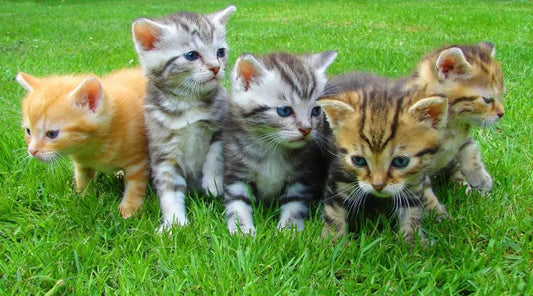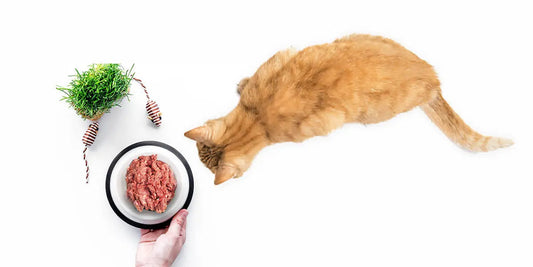
10 Foods Cats Can't Eat
Written by Darwin's
As a cat owner, you likely share a lot with your feline friend, like cuddles and cat naps. But what about food? When you’re popping open a can of tuna for lunch or searing a salmon in preparation for dinner, you may find yourself wondering: What foods can cats eat? Or, perhaps even more importantly, what foods can cats not eat?
Understanding your cat’s unique nutritional needs is an important aspect of maintaining their long-term health and wellness. So, find out what constitutes harmful cat food vs. safe cat food with our list of ten foods cats can’t eat.
Human Foods That Could Hurt Your Cat
A lot of cats are prone to snatching food from our plates the second our eyes drift away. They’re sneaky and fast hunters, after all.
However, there are many human foods that are toxic to our feline friends. Since our curious little scavengers don’t know the difference between safe food and harmful food, it’s up to us as owners to pay close attention to what our cats are eating and avoid leaving any of the following human food where your cat could swipe them:
- Grapes and raisins – For both cats and dogs alike, ingesting grapes or raisins can lead to kidney problems and even kidney failure.
- Chocolate – Though typically associated with dogs, chocolate isn’t a sweet treat for your cat, either. This is because chocolate contains caffeine and theobromine which can cause muscle tremors, seizures, and death.
- Onions and garlic – Garlic can cause gastrointestinal distress, while onions may break down red blood cells and cause anemia.
- Foods containing Xylitol – This artificial sweetener is toxic to both cats and dogs. It can be found in many candies and breath mints, as well as baked goods.
- Fruit pits – Apricot pits, peach pits, apple seeds, and cherry pits all contain arsenic and other toxins, in addition to posing a choking hazard.
- Avocado – Avocado contains persin, another toxin that can be deadly to cats.
- Rhubarb and tomato leaves and stems – Both of these items contain toxins that can cause the liver to fail.
If your kitty accidentally consumes any of these human foods, take them to the vet right away.
Fortunately, you can help prevent this emergency situation by keeping food out of your cat’s reach while you’re eating, never leaving food unattended, and never feeding them prepared meals that could potentially contain garlic, onions, or other toxic ingredients. If you're curious about safer alternatives, check out our guide on human foods cats can eat.
Foods You Should Avoid Feeding Your Cat
There are some foods that fall into a bit of a gray area when it comes to cat health. In other words, they aren’t outright poisonous to your cat, but they also aren’t the best thing for your cat to be chowing down on. However, because these foods are commonly associated with cats (particularly milk and raw fish), many people don’t realize that they can actually do harm
To that end, here are some food items you should avoid feeding your cat as they may do more long-term damage than you might think:
- Raw fish and raw meat – Potential bacteria in raw fish and meat could make your cat very sick. Additionally, raw fish contains an enzyme that can destroy thiamine, leading to neurological issues over time. The same also applies to raw meat and raw eggs.
- Fatty and greasy foods – Food that’s too rich in fat and grease can cause your cat to experience an upset stomach, vomiting, diarrhea, and potentially even pancreatitis.
- Milk or dairy products – Contrary to popular belief, many cats are lactose intolerant in adulthood. For this reason, consuming dairy products can lead to vomiting and diarrhea.
What Foods Can Cats Eat?
Now that you have a better idea of what foods cats can’t eat, let’s focus on what food and should be eating instead.
Fresh, Freeze-Dried, and Raw Diets
All-natural meals that come fresh, raw, or freeze-dried are leagues above even the finest of canned cat foods. If you have this option, you should opt for this type of cat’s diet.
Inspired by your cat’s ancestral diet, these types of meals utilize fresh, freeze-dried, and raw ingredients that are specifically formulated to meet your cat’s unique nutritional needs. They also avoid fillers and chemical preservatives that are found in other types of commercial cat food.
With the conscious, natural ingredients of fresh, freeze-dried, and raw diets, your cat can enjoy:
- A healthier gut
- Increased energy
- Weight loss (for overweight cats)
- Better dental health
- A healthier coat
High Moisture Foods
Water is a crucial and often overlooked part of a cat’s diet. In fact, most people remember proteins, fats, carbohydrates, minerals, and vitamins but forget about water.
Cats are, unfortunately more picky about their water sources than dogs are. Some refuse to drink unless they’re drinking from a running source of water, while others are picky about the location of their water dish.
If you find yourself running into these problems, adding high-moisture foods to your cat’s diet can be a great way to ensure they’re staying hydrated. For pre-made food, check the label to see whether it advertises itself as high moisture. Otherwise, you can always add moisture yourself by mixing your cat’s food with water.
Why You May Want to Avoid Canned and Dry Cat Food
For years, many pet owners believed they only had two options to choose from when it came to commercial cat food: wet and dry. Wet cat food is almost always referred to as canned food, and dry cat food is referred to as kibble.
Canned cat food long reigned as the “superior” choice between the two, but at the same time, canned cat food leaves a lot to be desired. This is because canned cat food:
- May cause dental problems in some cats
- May include filler ingredients with no nutritional value
- May make it harder to calorie track for your cat, causing them to gain weight
On the other hand, dry cat food has its own downsides. It can:
- Contain more preservatives
- Have a good deal of filler grains added
- Be less palatable to your cat
For these reasons, it’s much better to stick with a natural, raw food diet if possible.
What About Cat Treats?
As cat parents, we love spoiling our feline friends at every possible turn. In fact, you likely have a stash of cat treats waiting for them to eat right up. But when it comes to maintaining your cat’s health, should you be giving them treats at all?
The short answer is yes—giving your cat the occasional natural raw cat treats is perfectly fine. However, it’s important to remember that moderation is key.
If you give your cat too many cat treats, you could risk:
- Cat obesity due to the high caloric content of treats
- Your cat filling up on treats and not eating proper food with the right nutrients
- Gastrointestinal issues from having too much rich food and not enough healthy food
So, what does moderation look like when it comes to cat treats? Here’s a good rule of thumb to keep in mind: In general, treats shouldn’t make up more than 10% of your cat’s daily diet. This includes any treats you might give your cat to encourage them to take medicine.
Personalizing Your Pet’s Diet
Armed with your list of the 10 foods your kitty shouldn’t eat and the knowledge of the superiority of raw diets, you’re ready to start creating a top-notch meal plan for your pet. But of course, cats are just as varied as humans, so their diets can be just as versatile.
To that end, consider these various factors when determining the best type of diet for your cat:
- Your cat’s age – Just like humans, cats need different types and levels of nutrients at different ages. For instance, a one-month-old kitten isn’t going to need the same kind of food that a thirteen-year-old adult cat might, and vice-versa.
- Any health concerns – Certain health conditions demand different types of cat food. For example, some pet food brands manufacture food specifically for cats with bladder diseases. If your cat suffers from any type of health condition, make sure to discuss the most optimal diet options with your vet.
- Dental health – Similar to other health issues, dental problems may affect your cat’s diet. Your vet may direct you to certain types of food if your cat has dental concerns.
- Weight management – If you’re looking to bulk up or slim down your cat, you’ll want to pay close attention to the calorie density of each food you’re selecting.
- Your cat’s tastes – Cats can have a varied palate, and some are pickier than others. You might have to trial and error with different types and brands of food before your cat finally finds something they like.
By taking these factors into consideration, you’re showing your cat the love that comes from caring for their health.
Find the Right Food for Your Feline Friend With Darwin’s Natural Pet Products
So, what can your cat eat? If you’re looking for the most nutritious natural pet food options, Darwin’s makes it simple. At Darwin’s, we pride ourselves on offering true raw pet food that’s inspired by nature and informed by science. Our raw cat food is specifically formulated to hit all of the key points of nutrition that your cat needs, all while providing them with a taste they’ll savor and crave.
You don’t have to worry about depriving your cat of good food simply by being more cautious of what you feed them. With natural, ancestral-inspired natural cat food from Darwin’s, they’ll feel like every meal is a treat.
Sources:
- The Humane Society. Plants and food that can be poisonous to pets. https://www.humanesociety.org/resources/plants-and-food-can-be-poisonous-pets
- The American Veterinary Medical Association. 7 Foods to Avoid Feeding Your Dog or Cat. https://www.avma.org/resources/pet-owners/petcare/7-foods-avoid-feeding-your-dog-or-cat
- Association of American Feed Control Officials. Treats and Chews. https://www.aafco.org/consumers/understanding-pet-food/treats-and-chews/
- FEDIAF. The importance of water in your pet’s diet. https://europeanpetfood.org/pet-food-facts/fact-sheets/nutrition/the-importance-of-water-in-your-pets-diet/


